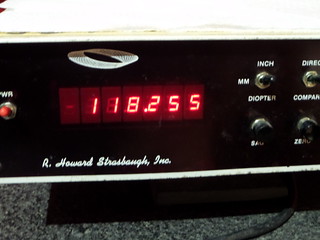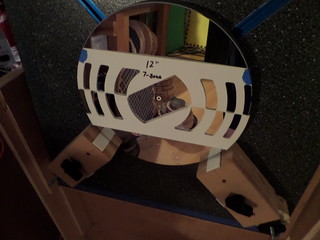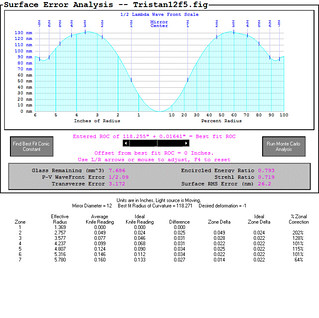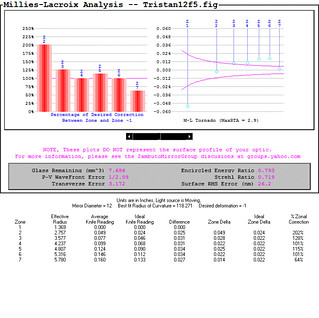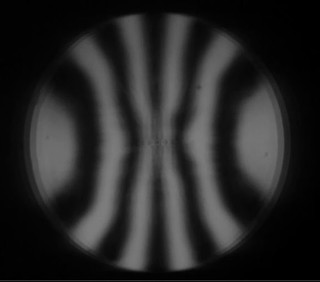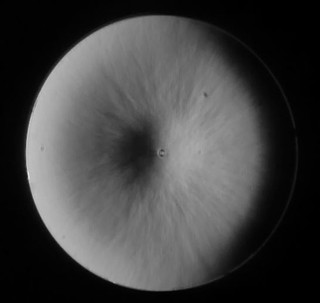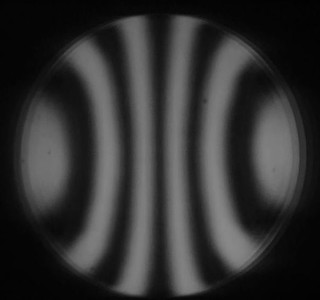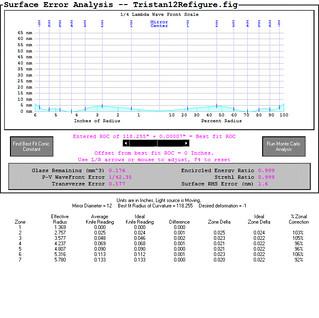A package arrived in the mail containing a 12" F5 telescope mirror. This was an inexpensive imported mirror, the type of commercial mirror you would expect to see in a sub-$1,000 reflector. The client wanted to know if the mirror would be a good candidate for refiguring. After unboxing, I let the mirror aclimate to the temperature in my testing room before taking some measurements and having a look at the surface quality. Below you see the spherometer reading on the mirror, showing a radius of 118.255 inches, which gives a focal length of 59.1 inches, or F5. After measuring the radius, I put the mirror on the test stand for Ronchi and Foucault tests. For the Foucault work, I used a seven-zone Couder mask, as seen here.
The numbers on this mirror were probably a little worse than average for imported mirrors in this class. FigureXP rated the mirror at about 1/2-wave, P-V on the wavefront. The Strehl ratio was reported as 0.719. These numbers are both quite a bit below where you would like to see a mirror. The classic minimum standards are 1/4-wave and 0.80 Strehl, so this mirror should show considerable performance improvement when upgraded to premium standards. The actual FigureXP results, pre-refig, are shown below.
The Ronchi and Foucault images (shown below) are quite telling. So many people ask about the quality of these inexpensive mirrors and the photos here are pretty easy to interpret. The Ronchi on the left shows several defects on this mirror. In a perfect Ronchigram, the bands would all be perfect parabolas, from end to end. On this mirror, you see a pinched area at the very center of the mirror. This is a deep hole, a low spot in the middle of the mirror. Notice also the discontinuities in the bands. They should be smooth, and every kink points to a zonal error on the surface. The Foucaultgram at right below shows the obvious central hole. In addition, all of the radial lines marring the surface are remnants of over-aggressive polishing and figuring strokes. A lot can go wrong during polishing to ruin the surface texture on a mirror. The pitch can be too hard, the strokes too fast, the pressure too high, and so on. In the end, a premium surface should show little if any surface texture. And anything that is visible like this will hurt the contrast performance from the mirror.
To refigure this mirror, I started with a total re-polish. The original surface showed a touch of astigmatism, so the full treatment was needed to make sure the 'stig was under control. After that, the mirror was figured just like any normal mirror. These imported mirrors aren't borosilicate, but are usually made of either soda-lime or BK7. The thermal properties of these glasses aren't as good as borosilicate, so the mirror requires longer waiting times between polishing and testing. The quality of the final surface is just as good on BK7 as on borosilicate. The only drawback is you will see slightly degraded performance on BK7 until the mirror comes to thermal equilibrium. So you either need patience to wait, or good fans on your mirror! Below are the Ronchigram and Foucaultgram on this mirror after the figuring process was finished. You easily see the difference in quality between the pairs of "before" and "after" tests.
I always run a multiple-pass, multiple-diameter Foucault test on a finished mirror. I feed the averages into FigureXP, and those test results are given below. I have to note that FigureXP is always optimistic in its numbers when used on a premium-quality mirror. FigXP reports the P-V wave rating at 1/42nd-wave, and shows a Strehl ratio of .999 here. First, please remember that this is the calculation from one test. Another test would give different results, potentially less enthusiastic! And second, I am not making any claim that this mirror is ACTUALLY a 1/42nd-wave .999 Strehl mirror. Those are just the numbers that FigXP calculates.
My actual shop standard is a statistical standard. My mirrors have an 80% probability of testing 1/10th-wave or better P-V on the wavefront, using a typical Foucault test and FigureXP data reduction. To meet this standard, my strategy is to just keep improving the mirror until it isn't really practical to try to make it any better. When I take this route, the mirrors usually test at least 1/18th wave, and usually get a Strehl of .98 or better. Again, I'm not claiming those numbers are real, but those are the optimistic numbers that FigureXP produces.
That being said, our mirrors usually produce a nearly perfect star test. The star test and actual observing experiences are the true test of any optic. In addition, I know of two of my clients who shipped my mirrors out for independent interferometric testing. In both cases, the Waite Research mirrors were reported with .97 Strehl ratios. Given that I wasn't aware of the independent testing in advance, and that those two mirrors were basically random samples of our mirrors, I am pretty happy with those results. Considering also that the test was done by a competing optician, I am comfortable with the quality of our mirrors, and with the fabrication and testing methods that we use here in the shop.
Postscript: The owner of this 12" F5 mirror and telescope has received the new mirror, installed it, and enjoyed "first light" with the refigured mirror. Here are some of his comments about his experiences with the Waite Research mirror's performance:

